Fabrication of Europium-Doped Barium Titanate/Polystyrene Polymer Nanocomposites Using Ultrasonication-Assisted Method: Structural and Optical Properties
Abstract
:1. Introduction
2. Experimental Details
2.1. Materials Used
2.2. Thermogravimetric Analysis
2.3. Characterizations
3. Theoretical Aspects
3.1. Lattice Parameters
3.2. Tolerance Factor
4. Results and Discussion
4.1. X-Ray Diffraction Analysis
4.2. Fourier-Transform Infrared (FTIR) Analysis
4.3. Morphological Study
4.4. UV-Visible Absorption Analysis
5. Conclusions
Supplementary Materials
Author Contributions
Funding
Institutional Review Board Statement
Informed Consent Statement
Data Availability Statement
Conflicts of Interest
References
- Yan, T.; Chen, H.; Yi, K.; Wang, J.; Xu, P.; Chu, B. Synergistic effect of barium titanate and insulating fillers on dielectric performance of sandwich-structured PLA composites. Compos. Commun. 2022, 29, 101027. [Google Scholar] [CrossRef]
- Li, H.; Wang, L.; Zhu, Y.; Jiang, P.; Huang, X. Tailoring the polarity of polymer shell on BaTiO3 nanoparticle surface for improved energy storage performance of dielectric polymer nanocomposites. Chin. Chem. Lett. 2021, 32, 2229–2232. [Google Scholar] [CrossRef]
- Pan, H.; Li, F.; Liu, Y.; Zhang, Q.; Wang, M.; Lan, S.; Zheng, Y.; Ma, J.; Gu, L.; Shen, Y.; et al. Ultrahigh–energy density lead-free dielectric films via polymorphic nanodomain design. Science 2019, 365, 578–582. [Google Scholar] [CrossRef] [PubMed]
- Yi, Z.; Wang, Z.; Li, Y.; Wu, D.; Xue, Y. Tunable BaxSr1-xTiO3 nanoparticles induced high energy storage density in layer-structured asymmetric polymer-based nanocomposites. Ceram. Int. 2022. [Google Scholar] [CrossRef]
- Zhang, Y.; Sun, H.; Chen, W. A brief review of Ba (Ti0. 8Zr0. 2) O3-(Ba0. 7Ca0. 3) TiO3 based lead-free piezoelectric ceramics: Past, present and future perspectives. J. Phys. Chem. Solids 2018, 114, 207–219. [Google Scholar] [CrossRef]
- Yu, S.; Ding, C.; Liu, Y.; Liu, Y.; Zhang, Y.; Luo, H.; Zhang, D.; Chen, S. Enhanced breakdown strength and energy density over a broad temperature range in polyimide dielectrics using oxidized MXenes filler. J. Power Sources 2022, 535, 231415. [Google Scholar] [CrossRef]
- Tang, X.; Din, C.; Yu, S.; Liu, Y.; Luo, H.; Zhang, D.; Chen, S. Synthesis of dielectric polystyrene via one-step nitration reaction for large-scale energy storage. Chem. Eng. J. 2022, 446, 137281. [Google Scholar] [CrossRef]
- Piana, F.; Cacciotti, I.; Šlouf, M.; Nanni, F.; Pfleger, J. One-pot preparation of surface-functionalized barium titanate nanoparticles for high-K polystyrene composite films prepared via floating method. J. Mater. Sci. 2018, 53, 11343–11354. [Google Scholar] [CrossRef]
- Ding, C.; Tang, X.; Yu, S.; Chen, S.; Liu, Z.; Luo, H.; Zhang, D. Concurrently enhanced dielectric properties and energy density in poly(vinylidene fluoride)-based core–shell BaTiO3 nanocomposites via constructing a polar and rigid polymer interfacial layer. J. Mater. Chem. C 2022, 10, 6323–6333. [Google Scholar] [CrossRef]
- Ye, J.; Zhang, B.; Jin, Y.; Zhang, H.; Qiao, Y.; Zhang, Z. 3D segregated architecture BaTiO3/polystyrene composites with enhanced dielectric constant fabricated via hot pressing core–shell polystyrene@BaTiO3 composite microspheres. J. Mater. Sci. Mater. Electron. 2020, 31, 3101–3110. [Google Scholar] [CrossRef]
- Shireesha, G.; Manjunatha, C.; Jain, A.; Radhakrishna, M.C. Influence of Cd0. 99Eu0. 01SiO3 nanoparticles concentration on Cd0. 99Eu0. 01SiO3/PVDF nanocomposite films. Mater. Today Proc. 2018, 5, 21162–21174. [Google Scholar] [CrossRef]
- Pithan, C.; Katsu, H.; Waser, R. Defect chemistry of donor-doped BaTiO3 with BaO-excess for reduction resistant PTCR thermistor applications–redox-behaviour. Phys. Chem. Chem. Phys. 2020, 22, 8219–8232. [Google Scholar] [CrossRef] [PubMed]
- Characterization of Minerals, Metals, and Materials 2018, SpringerLink. Available online: https://link.springer.com/book/10.1007/978-3-319-72484-3 (accessed on 20 September 2022).
- Fuentes, S.; Espinoza-González, R.; Rosales, M.; León, J. Effects of Eu3+ on the morphological, structural and optical properties of BaTiO3@ ZnO: Eu nanoparticles. J. Alloys Compd. 2020, 846, 156452. [Google Scholar] [CrossRef]
- Alshoaibi, A.; Saber, O.; Ahmed, F. Enhancement of optical activity and properties of barium titanium oxides to be active in sunlight through using hollandite phase instead of perovskite phase. Crystals 2021, 11, 550. [Google Scholar] [CrossRef]
- Aziz, S.B.; Hussein, S.; Hussein, A.M.; Saeed, S.R. Optical characteristics of polystyrene based solid polymer composites: Effect of metallic copper powder. Int. J. Met. 2013, 2013, 123657. [Google Scholar] [CrossRef] [Green Version]
- Khan, S.; Humera, N.; Niaz, S.; Riaz, S.; Atiq, S.; Naseem, S. Simultaneous normal–Anomalous dielectric dispersion and room temperature ferroelectricity in CBD perovskite BaTiO3 thin films. J. Mater. Res. Technol. 2020, 9, 11439–11452. [Google Scholar] [CrossRef]
- Soni, S.; Kumar, S.; Dalela, B.; Kumar, S.; Alvi, P.; Dalela, S. Defects and oxygen vacancies tailored structural and optical properties in CeO2 nanoparticles doped with Sm3+ cation. J. Alloys Compd. 2018, 752, 520–531. [Google Scholar] [CrossRef]
- Ye, C.; Yang, J.; Yao, L.; Chen, N. Regularities of formation and lattice distortion of perovskite-type compounds. Chin. Sci. Bull. 2002, 47, 458–460. [Google Scholar] [CrossRef]
- Moreira, R.L.; Dias, A. Comment on Prediction of lattice constant in cubic perovskites. J. Phys. Chem. Solids 2007, 68, 1617–1622. [Google Scholar] [CrossRef] [Green Version]
- Ubic, R.; Tolman, K.; Talley, K.; Joshi, B.; Schmidt, J.; Faulkner, E.; Owens, J.; Papac, M.; Garland, A.; Rumrill, C.; et al. Lattice-constant prediction and effect of vacancies in aliovalently doped perovskites. J. Alloys Compd. 2015, 644, 982–995. [Google Scholar] [CrossRef]
- Ubic, R. Revised method for the prediction of lattice constants in cubic and pseudocubic perovskites. J. Am. Ceram. Soc. 2007, 90, 3326–3330. [Google Scholar] [CrossRef]
- Smith, E.; Škapin, S.; Ubic, R. Correlative models for oxygen vacancies in perovskites. J. Alloys Compd. 2020, 836, 155475. [Google Scholar] [CrossRef]
- Wei, Y.; Cheng, Z.; Lin, J. An overview on enhancing the stability of lead halide perovskite quantum dots and their applications in phosphor-converted LEDs. Chem. Soc. Rev. 2019, 48, 310–350. [Google Scholar] [CrossRef] [PubMed]
- Padalia, D.; Bisht, G.; Johri, U.; Asokan, K. Fabrication and characterization of cerium doped barium titanate/PMMA nanocomposites. Solid State Sci. 2013, 19, 122–129. [Google Scholar] [CrossRef]
- Kumari, S.; Padalia, D.; Kumar, U.; Kumari, R. Investigation of structural properties of pure and Ce-doped barium titanate. Ionics 2022, 28, 4401–4411. [Google Scholar] [CrossRef]
- Pyykkö, P.; Atsumi, M. Molecular Single-Bond Covalent Radii for Elements 1-118. Chem. Eur. J. 2009, 15, 186–197. [Google Scholar] [CrossRef]
- Shaalan, N.; Hamad, D.; Abdel-Latief, A.; Abdel-Rahim, M. Preparation of quantum size of tin oxide: Structural and physical characterization. Prog. Nat. Sci. Mater. Int. 2016, 26, 145–151. [Google Scholar] [CrossRef] [Green Version]
- García-Hernández, M.; Chadeyron, G.; Boyer, D.; García-Murillo, A.; Carrillo-Romo, F.; Mahiou, R. Hydrothermal Synthesis and Characterization of Europium-doped Barium Titanate Nanocrystallites. Nano-Micro Lett. 2013, 5, 57–65. [Google Scholar] [CrossRef] [Green Version]
- Chae, D.W.; Kim, B.C. Characterization on polystyrene/zinc oxide nanocomposites prepared from solution mixing. Polym. Adv. Technol. 2005, 16, 846–850. [Google Scholar] [CrossRef]
- Chen, Q.; Hong, R.; Feng, W. Preparation and characterization of composites from Ba0.5Sr0.5TiO3 and polystyrene. J. Alloys Compd. 2014, 609, 274–283. [Google Scholar] [CrossRef]
- Makuła, P.; Pacia, M.; Macyk, W. How to correctly determine the band gap energy of modified semiconductor photocatalysts based on UV–Vis spectra. J. Phys. Chem. Lett. 2018, 9, 6814–6817. [Google Scholar] [CrossRef] [PubMed] [Green Version]
- Hussein, A.M.; Dannoun, E.M.A.; Aziz, S.B.; Brza, M.A.; Abdulwahid, R.T.; Hussen, S.A.; Rostam, S.; Mustafa, D.M.T.; Muhammad, D.S. Steps toward the band gap identification in polystyrene based solid polymer nanocomposites integrated with tin titanate nanoparticles. Polymers 2020, 12, 2320. [Google Scholar] [CrossRef] [PubMed]
- Ramakanth, S.; Raju, K.C.J. Band gap narrowing in BaTiO3 nanoparticles facilitated by multiple mechanisms. J. Appl. Phys. 2014, 115, 173507. [Google Scholar] [CrossRef]
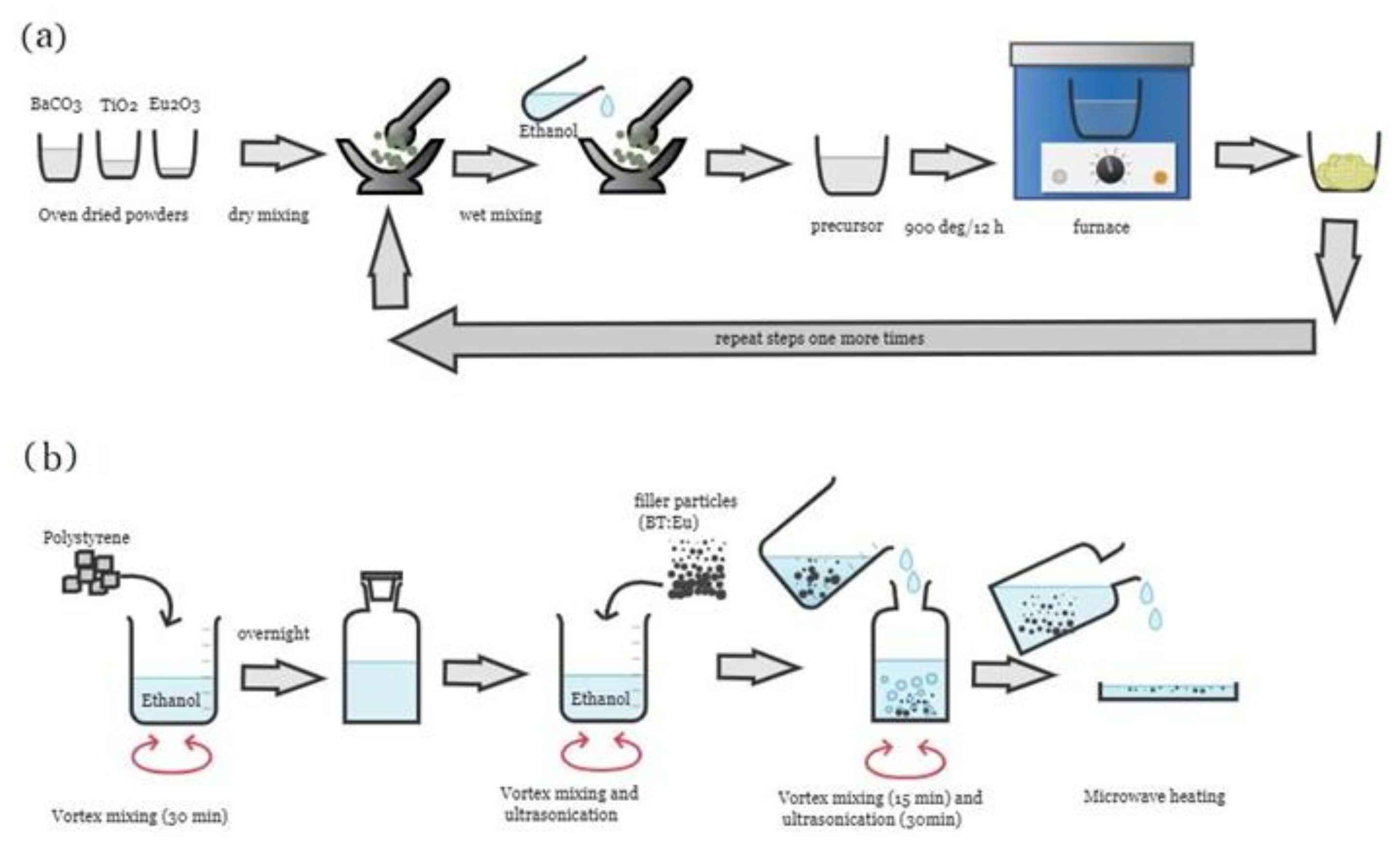


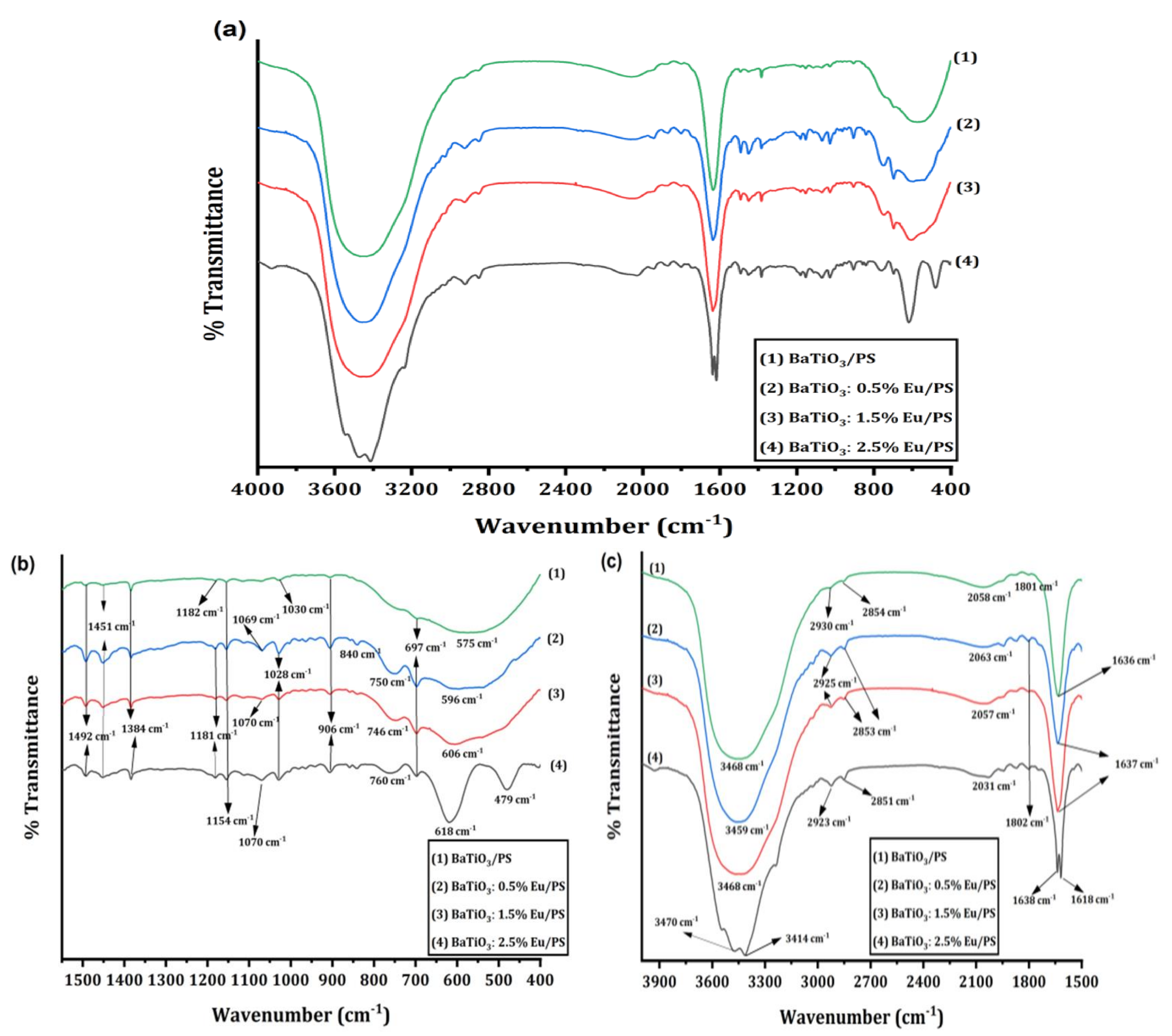
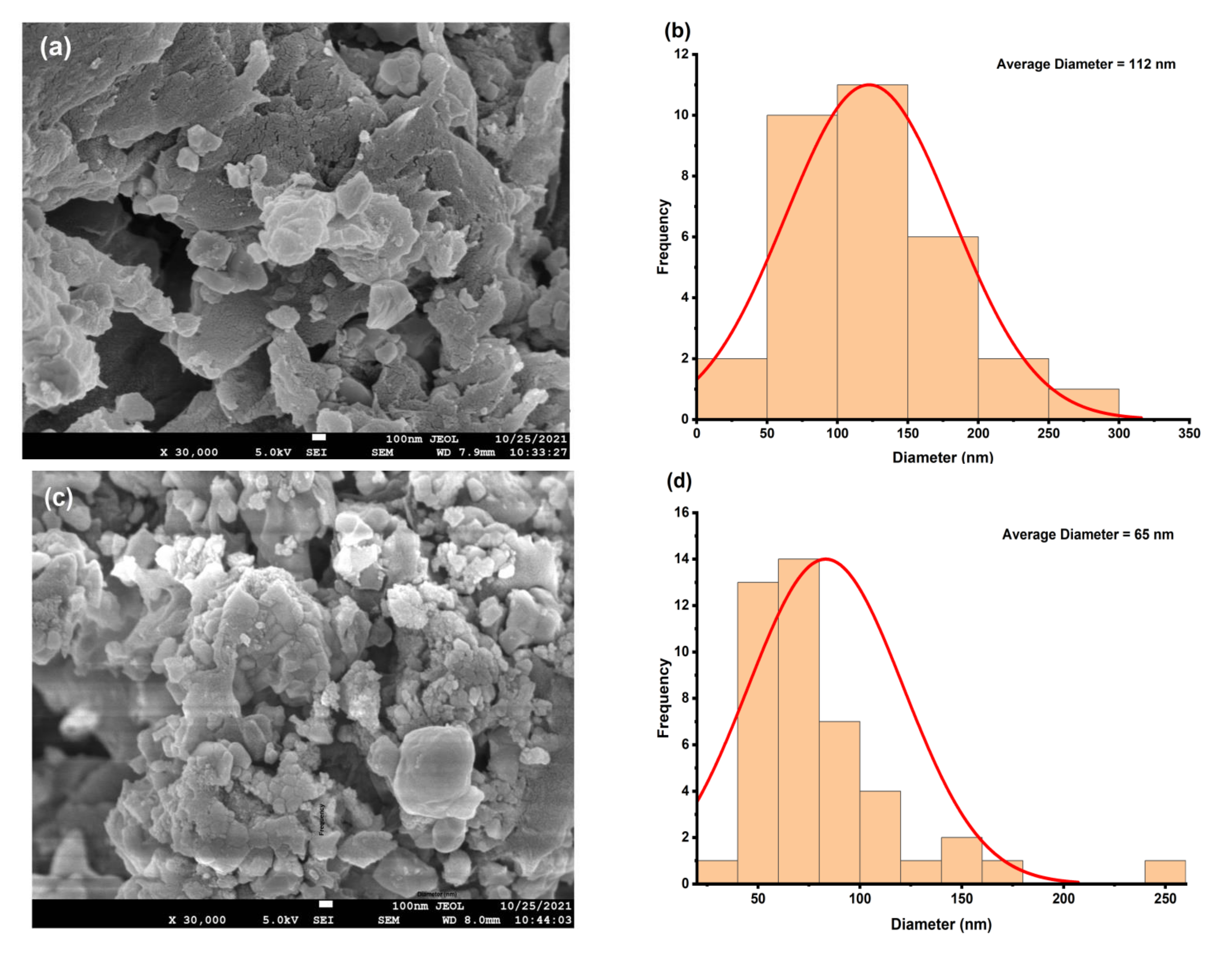
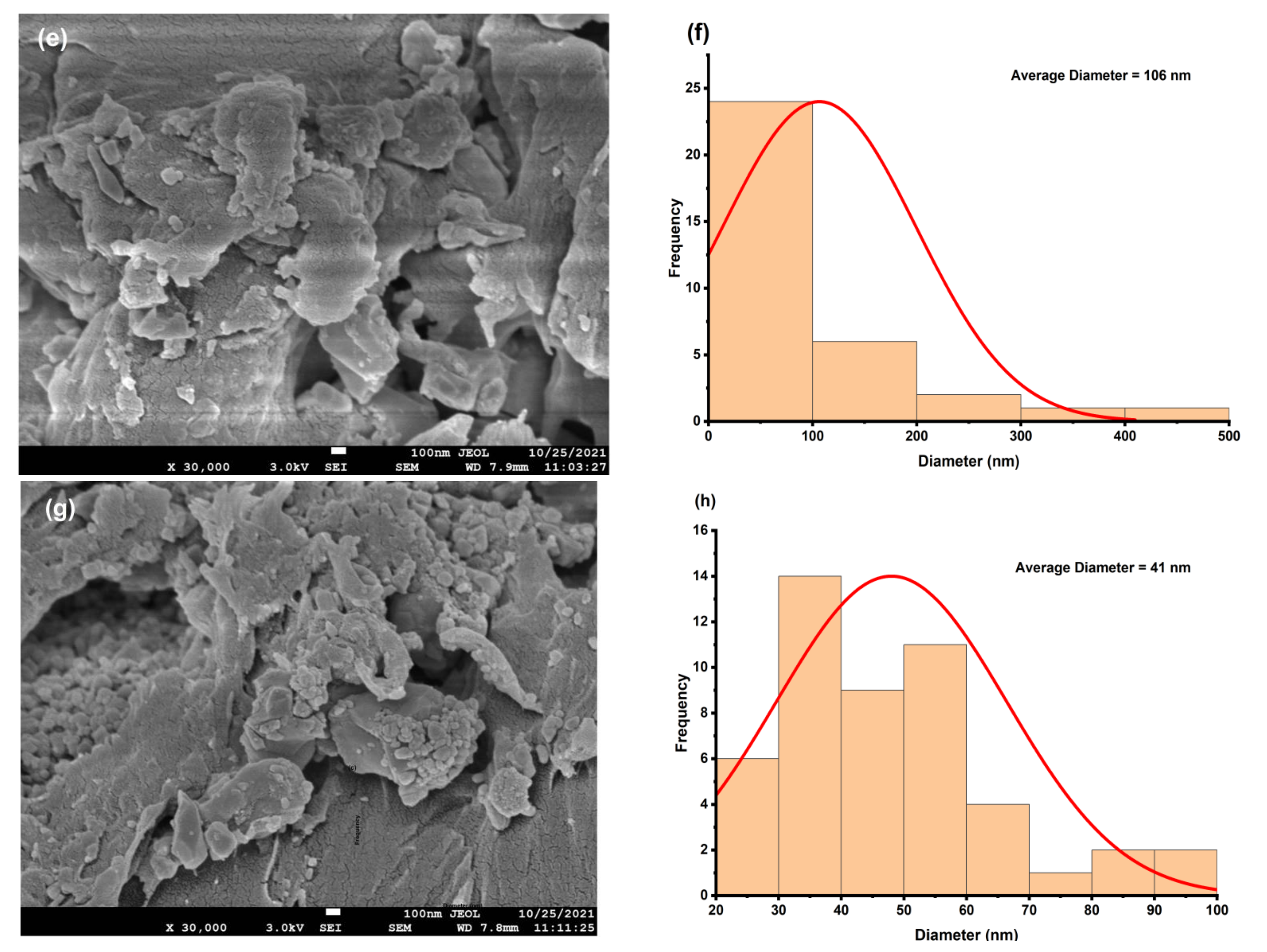
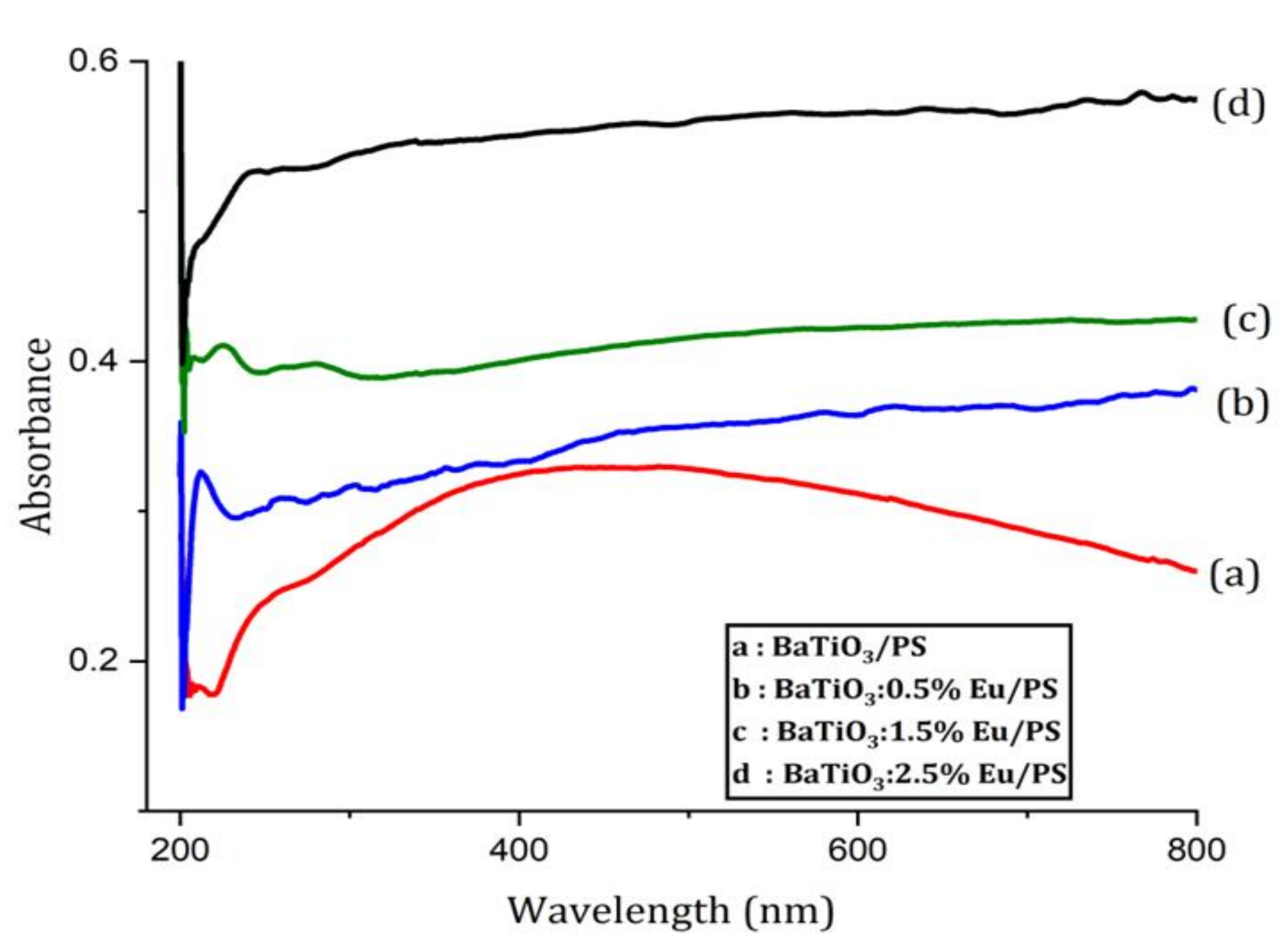

| Composition | D (Scherrer) nm | D (SSP) nm | d (FESEM) nm | n | δ × 10−3 (SSP, nm−2) | ε × 10−2 | Eg (eV) |
|---|---|---|---|---|---|---|---|
| x = 0.000 | 20.16 | 20.63 | 112 | 71.49515 | 2.35 | 1.47 | 4.35 |
| x = 0.005 | 27.61 | 12.61 | 65 | 16.45934 | 6.28 | 2.38 | 4.33 |
| x = 0.015 | 17.89 | 18.63 | 106 | 53.21427 | 2.88 | 1.41 | 4.29 |
| x = 0.025 | 19.58 | 16.76 | 41 | 38.40016 | 3.56 | 1.56 | 3.45 |
| Composition | (Equation (4)) | (Equation (5)) | (Equation (6)) | in nm | (Equation (7)) | t1 (Equation (8)) | t2 (Equation (9)) |
|---|---|---|---|---|---|---|---|
| x = 0.000 | 3.99737 | 3.99922 | 4.00704 | 4.00559 | 1.07061 | 1.0449 | 0.97614 |
| x = 0.005 | 3.99569 | 3.99689 | 4.00440 | 3.99488 | 1.06727 | 1.0446 | 0.97875 |
| x = 0.015 | 3.99233 | 3.99222 | 3.99911 | 3.99144 | 1.06445 | 1.04257 | 0.9796 |
| x = 0.025 | 3.98896 | 3.98756 | 3.99382 | 4.00334 | 1.06034 | 1.03546 | 0.97668 |
Publisher’s Note: MDPI stays neutral with regard to jurisdictional claims in published maps and institutional affiliations. |
© 2022 by the authors. Licensee MDPI, Basel, Switzerland. This article is an open access article distributed under the terms and conditions of the Creative Commons Attribution (CC BY) license (https://creativecommons.org/licenses/by/4.0/).
Share and Cite
Kumar, U.; Padalia, D.; Bhandari, P.; Kumar, P.; Ranakoti, L.; Singh, T.; Lendvai, L. Fabrication of Europium-Doped Barium Titanate/Polystyrene Polymer Nanocomposites Using Ultrasonication-Assisted Method: Structural and Optical Properties. Polymers 2022, 14, 4664. https://doi.org/10.3390/polym14214664
Kumar U, Padalia D, Bhandari P, Kumar P, Ranakoti L, Singh T, Lendvai L. Fabrication of Europium-Doped Barium Titanate/Polystyrene Polymer Nanocomposites Using Ultrasonication-Assisted Method: Structural and Optical Properties. Polymers. 2022; 14(21):4664. https://doi.org/10.3390/polym14214664
Chicago/Turabian StyleKumar, Umesh, Diwakar Padalia, Prabhakar Bhandari, Pawan Kumar, Lalit Ranakoti, Tej Singh, and László Lendvai. 2022. "Fabrication of Europium-Doped Barium Titanate/Polystyrene Polymer Nanocomposites Using Ultrasonication-Assisted Method: Structural and Optical Properties" Polymers 14, no. 21: 4664. https://doi.org/10.3390/polym14214664
APA StyleKumar, U., Padalia, D., Bhandari, P., Kumar, P., Ranakoti, L., Singh, T., & Lendvai, L. (2022). Fabrication of Europium-Doped Barium Titanate/Polystyrene Polymer Nanocomposites Using Ultrasonication-Assisted Method: Structural and Optical Properties. Polymers, 14(21), 4664. https://doi.org/10.3390/polym14214664













